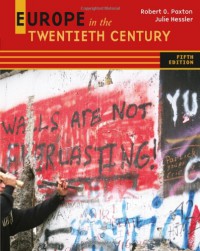Review: Europe in the Twentieth Century

This book was required reading for my 20th Century European History course as part of my university degree program. I should start off by saying my knowledge of history is truly horrible. The subject didn’t interest me at all when I was young, and I paid as little attention as possible. But I’m a lot older now (I’m a returning student, not a traditional college-aged student), and I enjoyed the opportunity to remedy some of my ignorance.
There were both good things and bad things about this book. I liked the way the book went into detail about the various events. It didn’t just say “this happened and then that happened”. It explained things from the perspectives of all of the major players involved so that I could better understand why things happened the way they did. For me, that was what made it really interesting – understanding how and why things happened. The authors also highlighted turning points, and even engaged in some speculation as to what might have happened if different paths were taken. As with any textbook there were parts that I found dry and boring, but I was more interested in what I was reading than I had hoped to be.
However, I had some real trouble with the organization of the material. The book jumped back and forth in time a lot. It often focused on one geographic area and/or topic and described events that happened over several years, and then it moved to a new area/topic and went back in time. The problem is that events were usually pretty intertwined. Things discussed in one section were often relevant to things discussed in other sections from the same time period. By splitting them up, I had trouble keeping track of the context of events and I had to do quite a bit of re-reading to keep track of what was happening when and how it was all connected.
The time hopping happened constantly throughout the book, and in many different forms. It happened between chapters, within chapters, and even within section breaks. One simple example of what I’m talking about occurred in Chapter 17. On page 492, the Common Market is being discussed. We’re told that it helped improve peace in Western Europe and, as an example of that improved peace, we’re told that German NATO troops were training on French soil in the mid-1960’s without creating any sort of a stir. Then, a little bit later on the same page, we switch to a topic that covers NATO and we’re back in 1948. So, on the very next page, the French are upset because a separate German army was being recreated.
This organization style also meant that terms, concepts, and people were sometimes introduced well before the sections where they were discussed in depth. I was constantly doing double takes and skimming back over previously-read material to try to understand apparent contradictions. And sometimes, the dates just weren’t mentioned that clearly. We also skipped around a bit with our assigned chapters in my class, although we did eventually read the entire book, so that exacerbated the problem. But there was plenty of confusion to be had for me within single chapters.
I can understand the purpose of focusing on one topic or region at a time. Europe is a large continent and there were lots of things going on, so it would surely be equally confusing if the authors had tried to present the entire history in precise chronological order. But I do think many of the topics were split out more than necessary and would have flowed better if discussed in chronological order within a single section. Another thing that might have helped would have been chapter timelines listing the major events discussed in the chapter in chronological order, with perhaps a higher-level timeline at the front of the book to help with keeping track of the big picture. Of course, if I’d had a better foundation in history to begin with, I might have been able to follow the book more easily.
 1
1
 2
2


